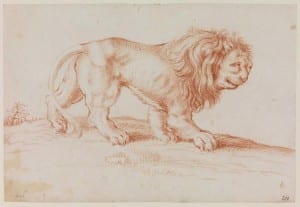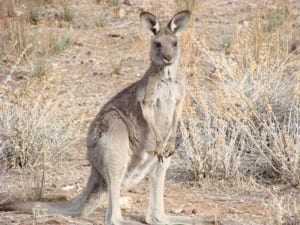Kangaroos cooked up by Cook / Strange Creatures
By Jack Ashby, on 13 March 2012
Seeing is believing, right? I’ve often looked at historic animal paintings and wondered “how come artists back in the day couldn’t draw animals?”. We’ve all seen images of animals that are extremely inaccurate, and our recent “Strange Creatures” event had works from UCL Art Museum pop-up in the Grant which included a poorly represented lion, simply because the artist had never seen one. This lack of first-hand inspiration is one reason that the paintings are unrealistic; artists were relying on written accounts by those who had seen the critters.

A late 17th Century Dutch representation of a lion from UCL Art Museum. The opportunity to study lions from life in 17th-century Northern Europe was rare. Lions were kept at the Doge’s Palace in Venice and appear in Jacopo Bellini’s (1400–70/1) sketchbooks, but most Northern artists had to depend upon the accounts of other eye-witnesses.
But reading these descriptions, another massive source of error is that those eye-witnesses are slaves to prior knowledge. When coming across new forms, unlike anything they’d seen before, many attempted to fit models of animals they already knew on top of what they saw. This is perfectly understandable, but in the end often unhelpful. It’s an interesting example of the brain over-riding the visual system and seeing what it thinks it should see.
I’m reading Captain Cook’s account of his first voyage to the South Seas, on the Endeavour, which includes the first descriptions of kangaroos that he came across when he landed on the east coast of Australia, and he was particularly guilty of this:
June 22nd 1770.
Some…reported that they had seen an animal as large as a greyhound, of a slender make, a mouse colour, and extremely swift.
It strikes me that although they had obviously seen it move, there is no mention of its most noticable trait – that it jumps rather than runs.
June 23rd.
…[A]lmost everybody has seen the animal…
June 24th
…I saw myself one of the animals…It was of a light mouse colour, and in size and shape very much resembled a greyhound;…
REALLY? A greyhound?!
… it had a long tail also, which it carried like a greyhound; and I should have taken it for a wild dog, if instead of running, it had not leapt like a hare or a deer…
Does it? When roos run, they do not do so like a hare or a deer, if you ask me.
…Its legs were said to be very slender, and the print of its foot to be like that of a goat…
In no way is this true. They do have two obvious toes, but their prints are the size and shape of your thumb and first finger together.
…July 8th
…some of our men saw four animals of the same kind, two of which Mr. Banks’ greyhound fairly chased [giving immediate comparison between the two]…These animals were observed not to run upon four legs, but to bound or hop forward on two.
Is it possible that it took two weeks to notice that kangaroos jump on two feet? It’s obviously difficult to disengage my modern experiences of kangaroos (afterall, that’s the point of this post), but I find it hard to accept that the first thing anyone wrote about a kangaroo wasn’t that it was a large animal jumping on just two feet. Instead, it was compared to an animal it resembles in very few ways – a greyhound.
July 14th
Mr. Gore, who went out this day with his gun, had the good fortune to kill one of the animals… In form it is most like the jerboa, which it also resembles in its motion, [fair] but it greatly differs in size…this animal, when full grown, being as big as a sheep…[then follows a reasonable description of its head, legs and tail]
…This animal is called by the natives Kangaroo. [much has been written about the veracity of this] The next day our kangaroo was dressed for dinner, and proved most excellent meat. On the 27th Mr. Gore shot a [larger, older] kangaroo…We dressed it for dinner the next day; but, to our great disappointment, we found it had a much worse flavour than that we had eated before.
One has to wonder how much the expedition’s scientist, Joseph Banks, one of the greatest naturalists ever, examined these two animals, which varied massively to anything known to science, before Cook had them cooked. He did eventually send some specimens back to John Hunter at the Royal College of Surgeons, but if it were me, I’d be keen to get a full scientific account of a specimen as soon as I could, and cooking it up for eating would only come later.
This brief excerpt compares eastern grey kangaroos to a greyhound (three times, in shape, size and tail), a wild dog, a hare and a deer (in movement), a goat (in footprint), a mouse (in colour), a jerboa (in movement and shape) and a sheep (in size). I’m surprised its taste didn’t suffer a comparison (slightly like lambs’ liver, if you ask me). We all have the benefit of knowing what kangaroos look like now, but I wonder if the human instinct to describe things in terms of known objects is a useful trait. Thanks to our brains’ insistence of fitting inaccurate models over visual stimuli, seeing is deceiving, as Jessie J says. Couldn’t we be a bit more imaginative?
5 Responses to “Kangaroos cooked up by Cook / Strange Creatures”
- 1
-
2
Book Worm… Kangaroo by John Simons: A Review | UCL UCL Museums & Collections Blog wrote on 19 April 2013:

[…] voyage, and the subsequent portrait by George Stubbs. Two coincidences here. One is that I wrote a piece about the failure of Cook to accurately describe kangaroos, relying too heavily on familiar species as comparisons. Second is that the famous Stubbs painting […]
-
3
Europe’s First Kangaroo and the Grant Museum: Save our Stubbs | UCL UCL Museums & Collections Blog wrote on 4 September 2013:

[…] I believe that the descriptions of Cook’s party’s early encounters with kangaroos were ridiculous, it was these encounters that began Europe’s relationship with Australasian […]
-
4
Love Perth wrote on 10 November 2013:
Have you read any Wilbur Smith, such as the Ballantyne or Courtney novels? That would give a real insight into how lions and other African animals were portrayed back to “civilized” culture three or four hundred years ago.
As for Kangaroos, the greyhound is an interesting comparison, especially to the Western Grey Kangaroo. Here’s a photo I took a while back, you can see some remarkable similarities to a greyhound – http://www.loveperth.com.au/wp-content/uploads/2012/05/preston-beach-kangaroos-000-copyright-loveperth-com-au.jpg
-
5
Specimen of the Week 283: The Eastern Quoll | UCL Museums & Collections Blog wrote on 17 March 2017:

[…] no need to relate them to any animal Europeans are more familiar with – as much as that is historically common practice – as they are on very distant branches of the mammal family tree and deserve recognition in […]
 Close
Close



Archaeologists are just as bad. We have ‘cornet cups’ from the Ghassulian period Levant (no, nothing to do with icecream), and ‘champagne cups’ from Ur, all based on vague shape resemblances to inappropriate modern vessels. And don’t let me get started on the hippo jar (which looks nothing like a hippo) …